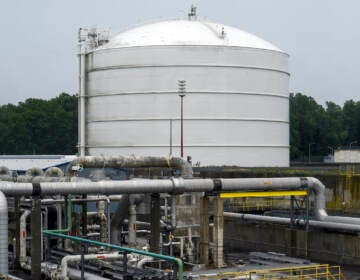Gloucester County LNG export terminal would take 360 trucks a day, 24/7, Army Corps says
Agency releases new details about planned Gloucester County facility after "conversations" with developer.

In this file photo, Liberian LNG tanker Al Hamra arrives at a port in Yokohama, southwest of Tokyo, Monday, April 21, 2014. (Koji Sasahara/AP Photo)
The U.S. Army Corps of Engineers divulged new details yesterday about plans for New Jersey’s first export terminal for liquefied natural gas, showing it would be supplied by as many as 15 trucks an hour — around the clock — to fill an ocean-going tanker every two weeks.
The previously unpublished information about the proposed terminal at Gibbstown in Gloucester County, the Army Corps said Tuesday, came from new details it had received about the plan by the developer, Delaware River Partners, since the agency published an earlier notice on the project in April.
The new document said LNG — a super-cooled form of natural gas that can explode if its vapor is mixed with air in an enclosed space — would not be processed or stored on site but would be pumped directly from trucks into ships.
To limit the impact of the heavy truck traffic on residential areas, Gloucester County is proposing a new access road to a port that would be expanded to accommodate the terminal, the document said. The new road would be about 110 feet from the nearest residential area; the terminal’s loading area would be built at least a mile away from those homes.
The developer has also proposed carrying the LNG to the terminal by rail but that idea hasn’t yet been approved by the U.S. Department of Transportation, the Army Corps report said. Until that happens, the Corps said it’s not possible to predict the volume of LNG that would arrive by rail or the number of trains.
Opening markets for fracked Marcellus Shale gas
The Corps, which must approve some aspects of the planned Gibbstown Logistics Center, said there was nothing inaccurate about its first notice, but that it wanted to “expand our discussion of the public interest factors relevant to the Corps of Engineers review” of the project.
But disclosure of the new detail may fuel critics who say that DRP and some government agencies have not been fully transparent about a project that would bring explosive materials to a residential area, and which would stimulate the production of fracked natural gas, boosting climate-changing carbon emissions.
The gas, harvested from Pennsylvania’s Marcellus Shale would be liquefied at a proposed plant in Bradford County, Pa., built by New Fortress Energy, a LNG company.
The terminal would expand the market for gas from the Marcellus geological formation — one of the biggest reserves in the world — after about a decade in which some of it has been “shut-in” because of a shortage of pipelines or other infrastructure for shipping it to customers.
If built, the Gibbstown facility would be the first LNG export terminal in New Jersey, and would join at least nine others around the country built over the last decade in response to the boom in production of natural gas obtained by fracking, also known as hydraulic fracturing.
Critics have accused DRP and some government agencies of covering up the details of their plans, which would result in 360 trucks a day, each carrying 12,000 gallons of LNG, leaving the planned liquefaction plant in northeastern Pennsylvania and arriving in Gibbstown 24 hours a day. The terminal would have the capacity to export 1.67 million barrels of LNG per month.
“New Fortress Energy keeps playing games, and only giving out little bits of information at a time,” said Jeff Tittel, director of the New Jersey Sierra Club. “Every day we look at this, the project gets bigger and more dangerous.”
‘Supplemental public notice’
Tittel argued that the Corps acted properly in issuing the new notice because it needed to make the public aware of the new information from the applicant.
A spokeswoman for DRP did not respond to a request for comment.
Steve Rochette, a spokesman for the Corps’ Philadelphia office, said the new notice arose from conversations with the applicant since the first notice was issued.
“As a result of those conversations, this office felt the public would benefit from a supplemental public notice explaining the project in more detail. This in turn will allow the public to better understand the project and address any concerns that may arise,” he wrote in an email.
In evaluating the application for permits, the Corps said it will consider a range of factors including whether the project would help to meet national and local energy needs; whether dredging and dock construction would affect water quality, and whether those activities would erode shorelines.
DRP’s plans to dredge the Delaware River and construct an extra dock got a green light last month from the Delaware River Basin Commission in the face of criticism from environmentalists that it had not allowed the public the opportunity to comment. The DRBC said this week it is considering a request by the environmental group Delaware Riverkeeper Network to take another look at its approval, and hold a public hearing.
WHYY is your source for fact-based, in-depth journalism and information. As a nonprofit organization, we rely on financial support from readers like you. Please give today.




